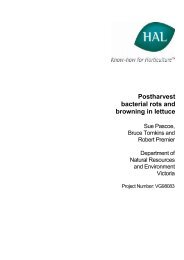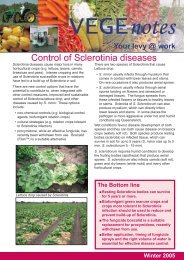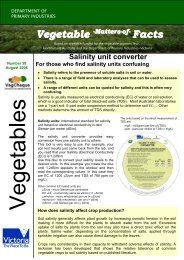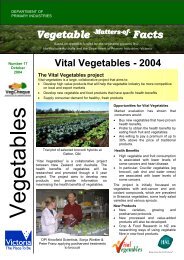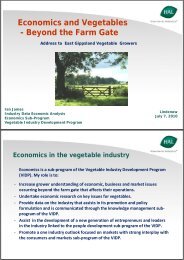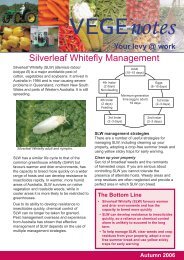Developing strategies to stimulate local consumption, export and ...
Developing strategies to stimulate local consumption, export and ...
Developing strategies to stimulate local consumption, export and ...
Create successful ePaper yourself
Turn your PDF publications into a flip-book with our unique Google optimized e-Paper software.
3. Literature Review3.1 IntroductionWhile the volume <strong>and</strong> variety of vegetables offered <strong>to</strong> Australian consumers have increaseddramatically over the last 20 years, the interest in some such as the globe artichoke hasremained almost static. This is in spite its versatility as a vegetable <strong>and</strong> its well documentedexcellent health benefits. In Australia, the interest in globe artichoke (particularly in its freshform) remains largely restricted <strong>to</strong> particular ethnic groups who are familiar with its use. Thiscould be attributed <strong>to</strong> a number of reasons such as unfamiliarity of the majority of consumerswith this vegetable, difficulty in its preparation, competition from processed forms of tiheproduct <strong>and</strong> lack of promotion of artichokes on domestic markets.This project aimed at: a) Describing the current status of the Australian globe artichokeindustry <strong>and</strong> identifying the major barriers <strong>to</strong> its expansion b) Identifying <strong>local</strong> <strong>and</strong> <strong>export</strong>market opportunities c) Testing the technical feasibility <strong>and</strong> development of value addedartichoke products d) Assessing the consumer's acceptability of such products. The projectaimed also at documenting <strong>to</strong> the industry the achievable benefits of processing <strong>and</strong> valueadding as a viable <strong>and</strong> complementary alternative <strong>to</strong> its present focus on the limited <strong>and</strong>unpredictable fresh market. The project also <strong>to</strong>uched on the import replacement issue <strong>and</strong>reviewed the capacity of the artichoke producers in meeting the requirements of a <strong>local</strong>processing industry. Furthermore, as part of this project, an overseas visit was undertaken bythe principal investiga<strong>to</strong>r <strong>to</strong> attend the 4 th International Congress on Globe Artichoke in Italy<strong>and</strong> <strong>to</strong> review the progress in artichoke processing in two leading countries in this field (seesummary report in Appendix 8).The final outcome of the information gathered will be a re-positioning of the globe artichokeindustry <strong>to</strong> increase production in the face of an anticipated increase in <strong>local</strong> <strong>consumption</strong> <strong>and</strong><strong>export</strong> opportunities.The approach taken in this project for solving the problems associated with a crop such asglobe artichoke could be applicable <strong>to</strong> other marginal vegetable crops. Therefore, it is hopedthat this report would be a stepping s<strong>to</strong>ne for the initiation of further research projects thataddress value adding <strong>and</strong> marketing in other vegetable crops with similar predicaments <strong>to</strong>globe artichoke.3.2 Botany <strong>and</strong> agronomy of globe artichokeThe globe artichoke {Cynara scolymus) belongs <strong>to</strong> the compositae family <strong>and</strong> is one of thefew vegetable crops that can be grown as an annual or as a perennial. It is native <strong>to</strong> theMediterranean region, possibly the Middle East, hence the Arabic origin of the name(ardichoki) meaning "earth thorn" (Simpson <strong>and</strong> Ogorzaly, 1995). The genus Cynaracomprises seven wild species also native of the Mediterranean basin with the wild cardoon{Cynara cardunculus) considered the closest relative <strong>and</strong> the primary wild gene-pool <strong>to</strong> thecultivated globe artichoke (Rottenberg <strong>and</strong> Zohary, 2000). The globe artichoke should not beconfused with the Jerusalem artichoke (Helianthus tuberosus L.) a plant native <strong>to</strong> theAmericas <strong>and</strong> related <strong>to</strong> the sunflower (Schultheis, 1999) or the Chinese artichoke (Stachyssieboldii Miq.), both of which are grown for their edible tubers. From its origin as a wildplant, the globe artichoke has developed <strong>to</strong> become a luxury vegetable as we know it now,cultivated for its edible immature floral bud (head) which is available from late autumn <strong>to</strong>early spring (Plate 1).




